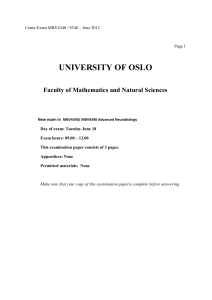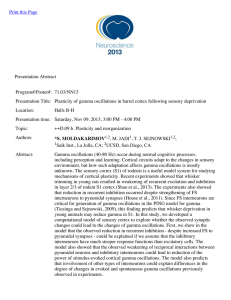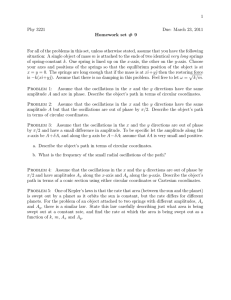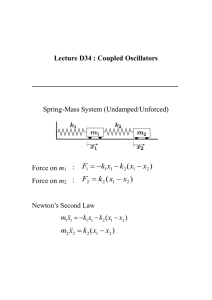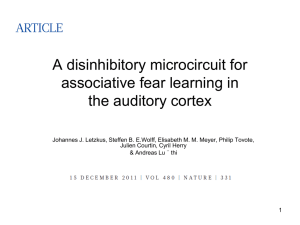Frequency Dependence of Spike Timing Reliability in Cortical
advertisement
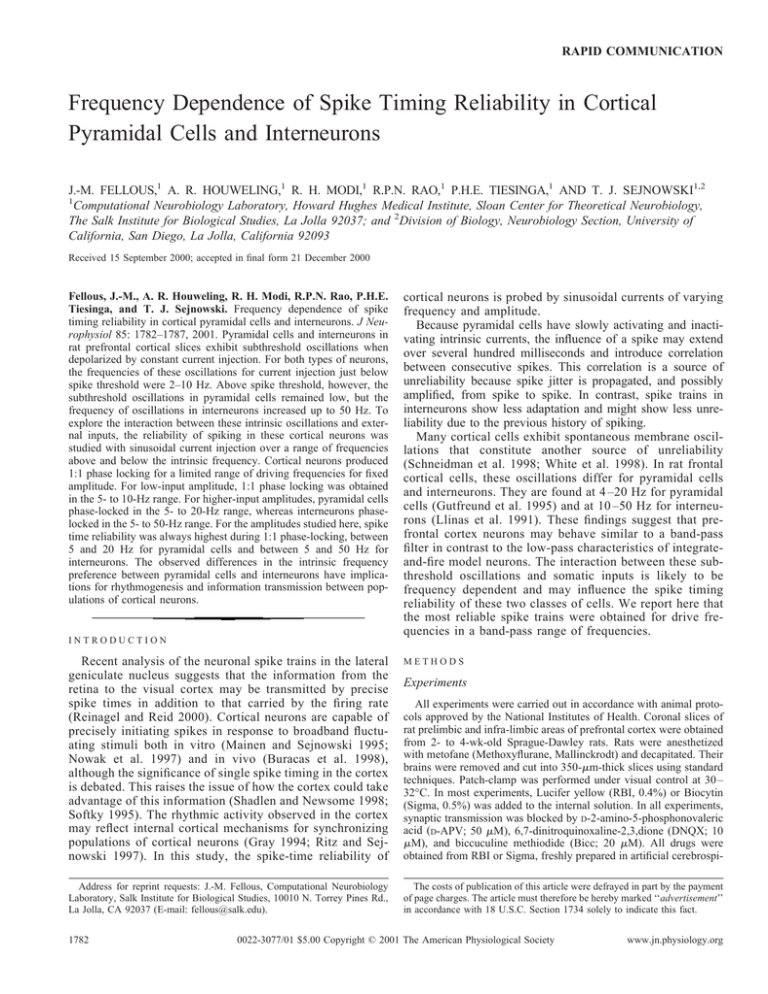
RAPID COMMUNICATION Frequency Dependence of Spike Timing Reliability in Cortical Pyramidal Cells and Interneurons J.-M. FELLOUS,1 A. R. HOUWELING,1 R. H. MODI,1 R.P.N. RAO,1 P.H.E. TIESINGA,1 AND T. J. SEJNOWSKI1,2 1 Computational Neurobiology Laboratory, Howard Hughes Medical Institute, Sloan Center for Theoretical Neurobiology, The Salk Institute for Biological Studies, La Jolla 92037; and 2Division of Biology, Neurobiology Section, University of California, San Diego, La Jolla, California 92093 Received 15 September 2000; accepted in final form 21 December 2000 Fellous, J.-M., A. R. Houweling, R. H. Modi, R.P.N. Rao, P.H.E. Tiesinga, and T. J. Sejnowski. Frequency dependence of spike timing reliability in cortical pyramidal cells and interneurons. J Neurophysiol 85: 1782–1787, 2001. Pyramidal cells and interneurons in rat prefrontal cortical slices exhibit subthreshold oscillations when depolarized by constant current injection. For both types of neurons, the frequencies of these oscillations for current injection just below spike threshold were 2–10 Hz. Above spike threshold, however, the subthreshold oscillations in pyramidal cells remained low, but the frequency of oscillations in interneurons increased up to 50 Hz. To explore the interaction between these intrinsic oscillations and external inputs, the reliability of spiking in these cortical neurons was studied with sinusoidal current injection over a range of frequencies above and below the intrinsic frequency. Cortical neurons produced 1:1 phase locking for a limited range of driving frequencies for fixed amplitude. For low-input amplitude, 1:1 phase locking was obtained in the 5- to 10-Hz range. For higher-input amplitudes, pyramidal cells phase-locked in the 5- to 20-Hz range, whereas interneurons phaselocked in the 5- to 50-Hz range. For the amplitudes studied here, spike time reliability was always highest during 1:1 phase-locking, between 5 and 20 Hz for pyramidal cells and between 5 and 50 Hz for interneurons. The observed differences in the intrinsic frequency preference between pyramidal cells and interneurons have implications for rhythmogenesis and information transmission between populations of cortical neurons. INTRODUCTION cortical neurons is probed by sinusoidal currents of varying frequency and amplitude. Because pyramidal cells have slowly activating and inactivating intrinsic currents, the influence of a spike may extend over several hundred milliseconds and introduce correlation between consecutive spikes. This correlation is a source of unreliability because spike jitter is propagated, and possibly amplified, from spike to spike. In contrast, spike trains in interneurons show less adaptation and might show less unreliability due to the previous history of spiking. Many cortical cells exhibit spontaneous membrane oscillations that constitute another source of unreliability (Schneidman et al. 1998; White et al. 1998). In rat frontal cortical cells, these oscillations differ for pyramidal cells and interneurons. They are found at 4 –20 Hz for pyramidal cells (Gutfreund et al. 1995) and at 10 –50 Hz for interneurons (Llinas et al. 1991). These findings suggest that prefrontal cortex neurons may behave similar to a band-pass filter in contrast to the low-pass characteristics of integrateand-fire model neurons. The interaction between these subthreshold oscillations and somatic inputs is likely to be frequency dependent and may influence the spike timing reliability of these two classes of cells. We report here that the most reliable spike trains were obtained for drive frequencies in a band-pass range of frequencies. Recent analysis of the neuronal spike trains in the lateral geniculate nucleus suggests that the information from the retina to the visual cortex may be transmitted by precise spike times in addition to that carried by the firing rate (Reinagel and Reid 2000). Cortical neurons are capable of precisely initiating spikes in response to broadband fluctuating stimuli both in vitro (Mainen and Sejnowski 1995; Nowak et al. 1997) and in vivo (Buracas et al. 1998), although the significance of single spike timing in the cortex is debated. This raises the issue of how the cortex could take advantage of this information (Shadlen and Newsome 1998; Softky 1995). The rhythmic activity observed in the cortex may reflect internal cortical mechanisms for synchronizing populations of cortical neurons (Gray 1994; Ritz and Sejnowski 1997). In this study, the spike-time reliability of All experiments were carried out in accordance with animal protocols approved by the National Institutes of Health. Coronal slices of rat prelimbic and infra-limbic areas of prefrontal cortex were obtained from 2- to 4-wk-old Sprague-Dawley rats. Rats were anesthetized with metofane (Methoxyflurane, Mallinckrodt) and decapitated. Their brains were removed and cut into 350-m-thick slices using standard techniques. Patch-clamp was performed under visual control at 30 – 32°C. In most experiments, Lucifer yellow (RBI, 0.4%) or Biocytin (Sigma, 0.5%) was added to the internal solution. In all experiments, synaptic transmission was blocked by D-2-amino-5-phosphonovaleric acid (D-APV; 50 M), 6,7-dinitroquinoxaline-2,3,dione (DNQX; 10 M), and biccuculine methiodide (Bicc; 20 M). All drugs were obtained from RBI or Sigma, freshly prepared in artificial cerebrospi- Address for reprint requests: J.-M. Fellous, Computational Neurobiology Laboratory, Salk Institute for Biological Studies, 10010 N. Torrey Pines Rd., La Jolla, CA 92037 (E-mail: fellous@salk.edu). The costs of publication of this article were defrayed in part by the payment of page charges. The article must therefore be hereby marked ‘‘advertisement’’ in accordance with 18 U.S.C. Section 1734 solely to indicate this fact. 1782 METHODS Experiments 0022-3077/01 $5.00 Copyright © 2001 The American Physiological Society www.jn.physiology.org RELIABILITY OF PYRAMIDAL CELLS AND INTERNEURONS 1783 FIG. 1. Subthreshold oscillations in pyramidal cells and interneurons. A, top: subthreshold oscillations in a pyramidal cell for low (left)- and high (right)-amplitude current steps. Note the presence of subthreshold oscillations in the theta range (■). Bottom: subthreshold oscillations in an interneuron for low (left)- and high (right)-amplitude current steps. Note the presence of subthreshold oscillations in the theta (■) and gamma (䊐) ranges. B: group data for 13 pyramidal cells (left) and 11 interneurons (right). Subthreshold oscillations are limited to the theta range for both pyramidal cells and interneurons if the membrane potential remains near or below threshold (about ⫺52 mV on average). If the amplitude of the current is sufficient to elicit multiple spiking, the subthreshold oscillations are dominated by 5- to 15-Hz oscillations for pyramidal cells and 10- to 50-Hz oscillations for interneurons. nal fluid (ACSF) and bath applied. Data were acquired with Labview 5.0 and a PCI-16-E1 data-acquisition board (National Instrument) and analyzed with MATLAB (The Mathworks). We recorded from regularly spiking layer 5 pyramidal cells and layer 5/6 interneurons, which were characterized by high firing rates, no adaptation, and prominent fast spike repolarization. Both pyramidal cells and interneurons were identified morphologically. A total of 13 pyramidal cells and 11 interneurons was used in this study. Mean input resistance for pyramidal cells was 85 and 235 M⍀ for interneurons. Sinusoidal currents with a DC offset equal to the amplitude were injected into the soma. The “low” current amplitude was adjusted for each neuron so that the neuron did not spike with a 0.5 Hz drive but did spike at higher driving frequencies. The low current ranged between 30 and 80 pA peak-to-peak depending on the input resistance of the particular cell. Medium and high amplitudes were 1.5 and 2 times the low amplitude, respectively. Data analysis The frequency content of subthreshold oscillations (Fig. 1) was obtained from the power spectrum (Welch’s averaged periodogram method in MATLAB) of spike-free traces located at least 500 ms after the start of each record. This eliminated artifacts due to the onset of the current pulse. A dominant frequency was considered present in the record only if at least three cycles were present and if its power spectrum amplitude consisted of a peak that was at least 30% larger than the amplitude of any other peaks. In Fig. 3C, the average dominant frequency of subthreshold oscillations (Fig. 1) was computed for traces “around threshold” that were obtained with constant current injection values that yielded on average between 0.33 and 5 spikes per trial. The spike time histogram was computed on the basis of 10 –15 trials, each lasting 2 s and binned using a window of 6 ms. A transient of 1,000 ms in the histogram was discarded, and only the bins totaling more than seven trials were considered, all other bins were set to zero. The histogram was low-pass filtered (100 Hz cutoff). The peaks of the smoothed histogram were extracted. Peaks that exceeded 80% of the maximum peak were considered reliable events. Spikes were considered part of the event if their time of occurrence fell within the time window defined by the mid height of the event. Reliability was computed as the ratio between the total number of spikes included in reliable events divided by the total number of spikes present in all the trials. Reliability was between 0 and 1. Results are given as means ⫾ SD. RESULTS Both pyramidal cells and interneurons exhibited membrane potential oscillations when depolarized by constant current 1784 FELLOUS, HOUWELING, MODI, RAO, TIESINGA, AND SEJNOWSKI FIG. 2. Resonance and spike timing reliability in a pyramidal cell and in an interneuron injected with sinusoidal currents. A: at 6 Hz and low amplitudes, both pyramidal cells and interneurons can fire 1:1 with the current drive. If the amplitude is kept constant, but the frequency is reduced, firing is prevented (0.5 Hz) and subthreshold oscillations appear (*). Higher frequencies (60 Hz) are filtered out and spiking is suppressed or greatly reduced. B: interneuron reliability. Left: rastergrams for low-amplitude stimulation. Low frequencies elicit none or infrequent spikes (cf. 0.5 Hz). Medium frequency elicits 1:1 entrainment and reliable spiking (cf. 9 Hz). High frequencies elicit unreliable spiking (cf. 40 Hz). 3, the frequency corresponding to the highest reliability (7 trials shown). Right: high-amplitude stimulation of the same frequencies as in A. Note that the frequency yielding the maximal reliability has shifted to 45 Hz (4; 6 trials shown). injection at the soma (13 pyramidal cells, 11 interneurons, Fig. 1A). The frequency of these oscillations was voltage dependent and differed between the two classes of cells. When a cell was depolarized and no spikes or only a few spikes appeared at the start of the current injection (Fig. 1A, left), the frequency of the subthreshold oscillation was restricted to the theta range (Fig. 1B; 4.9 ⫾ 1.9 Hz for pyramidal cells, 5.9 ⫾ 2.7 Hz for interneurons) and did not depend on the average membrane potential. For current pulses that elicited repeated spiking after the initial injection transient (Fig. 1A, right), subthreshold oscillations in pyramidal cells remained in the theta range (9.9 ⫾ 3.6 Hz) with a slight voltage dependence (0.38 Hz/mV). However, subthreshold oscillations in interneurons occurred in the beta and gamma ranges (26.7 ⫾ 19.3 Hz) and had a steeper voltage dependence (1.97 Hz/mV) than pyramidal cells (Fig. 1B). For each neuron, responses to eight different current amplitudes were measured (range 25–150 pA). The voltage dependence of the membrane potential oscillations was similar between different interneurons and between different pyramidal cells. Cells were then driven by sinusoidal current injections with constant amplitude and a DC offset equal to the amplitude, over a range of frequencies and amplitudes. For low-current amplitude, low frequencies with slowly varying depolarizations could elicit theta-frequency subthreshold oscillations without spiking (Fig. 2A, asterisk). However, when the frequency of the sine wave was increased to the theta-range, both pyramidal cells and interneurons elicited spikes that were entrained 1:1 to the sinusoidal drive (Fig. 2A, 6 Hz). Further increases in frequency resulted in cycle skipping (Fig. 2B), and, for sufficiently high frequencies, the spiking stopped (pyramidal cells) or was unrelated to the drive frequency (interneurons; Fig. 2A, 60 Hz). As the amplitude of the sine wave was increased, the range of 1:1 spiking was extended and shifted to higher frequencies for both pyramidal cells and interneurons. Pyramidal cells were capable of 1:1 spiking up to approximately 15 Hz (data not shown), while interneurons could phase lock to frequencies as high as 45 Hz (Fig. 2B). For input amplitudes above twice the low-current amplitude, these limiting frequencies did not change in most cases but eventually resulted in damage to the cells. This frequency saturation did not occur for large amplitude pulses of DC current that could elicit spiking at very high rates in both pyramidal cells and interneurons. Repeated presentations of sine waves at constant amplitude showed that the reliability of spiking depended on the frequency of the stimulus. For pyramidal cells and interneurons driven by a sine wave input near threshold, reliability was the highest in the theta range (Fig. 2B, low amplitude, arrow). An increase in the amplitude of the sine wave yielded an increase in the frequency of highest reliability (Fig. 2B, high-amplitude, arrow). In this regime, low-frequency input waves yielded multiple unreliable spiking per cycle, while at high frequencies there was random cycle skipping. Highest reliability was always observed in the 1:1 regime, but not all frequencies in the 1:1 regimes were equally reliable (e.g., Fig. 2B, low amplitude). Figure 3 shows the group data for 13 pyramidal cells and 11 interneurons. At the minimal sine amplitudes eliciting a subthreshold resonance, the reliability of spike timing was maxi- RELIABILITY OF PYRAMIDAL CELLS AND INTERNEURONS 1785 FIG. 3. Frequency dependence of spike timing reliability for pyramidal cells and interneurons. A: group data for 13 pyramidal cells. Spike timing reliability vs. frequency for 3 sine wave amplitudes of stimulation. Left: graphs are obtained with the minimum amplitude required to get resonance (as in Fig. 2A). Reliability is also shown for inputs with sine wave amplitudes 50% greater than the minimum (middle) and twice the minimum (right). Note that as amplitude is increased, the frequency of maximal reliability (black arrows) is shifted toward higher frequencies (but remain below 20 Hz), and the absolute value of the peak is increased. B: group data for 11 interneurons. Same as in A. Note that at higher amplitudes, maximal reliability is achieved for frequencies in the beta and gamma ranges (open arrow). Maximal reliability occurs at frequencies in the same range as the subthreshold oscillations (Fig. 1). C: correlation between average subthreshold oscillation frequency just below threshold and the frequency for highest reliability for low current amplitude in 6 pyramidal cells (open circle) and 6 interneurons (⫻). Correlation coefficient was 0.89 (Pearson). mal in the theta range (6 Hz for pyramidal cells, 4 – 6 Hz for interneurons) and dropped sharply as frequency was decreased or increased (Fig. 3A). These experiments were repeated at 1.5 times and twice the minimal amplitude. The peak of reliable spiking increased in frequency and absolute value, as the input amplitude was increased. At the highest amplitude tested, pyramidal cells were most reliable at 15 Hz (reliability, 0.67), but interneurons exhibited reliable spiking between 15 and 60 1786 FELLOUS, HOUWELING, MODI, RAO, TIESINGA, AND SEJNOWSKI Hz. Reliability differences between these frequencies were not significant (average reliability, 0.83). For all cells, maximal reliability was always achieved in the 1:1 entrainment regime (Fig. 2B). Below spike threshold and for low-current amplitudes, the average frequency of subthreshold oscillations elicited by current pulse injections was highly correlated with the frequency of the sine waves that elicited maximal reliability (Fig. 3C, Pearson correlation, 0.89). Although this study was based on rat prefrontal cortex cells, similar results were obtained in other cortical cells including somatosensory cortex pyramidal cells (n ⫽ 3) and interneurons (n ⫽ 3), hippocampus CA1 pyramidal cells (n ⫽ 4), and stratum radiatum interneurons (n ⫽ 3) (data not shown). DISCUSSION The voltage dependence of subthreshold oscillations was investigated by injecting constant depolarizing currents of increasing amplitudes. For both pyramidal cells and interneurons, the frequency of subthreshold oscillations was almost constant below spike threshold but increased with average membrane potential above threshold. Interneurons could sustain higher frequency subthreshold oscillations (2–50 Hz) than pyramidal cells (2–20 Hz). This may be explained by differences in the distribution and types of voltage-gated channels between pyramidal cells and interneurons. The effects of the difference in intrinsic neuronal properties on spike-timing reliability were investigated by injecting sinusoidal currents with different amplitudes and frequencies. The main result was that for the current amplitudes used here, the driving frequency for which maximum reliability could be obtained was between 5 and 20 Hz for pyramidal cells, whereas for interneurons, it was between 5 and 50 Hz. For drive frequencies below 4 Hz, the number of spikes per cycle was highly variable, hence a low reliability was obtained. Prolonged injections with amplitudes higher than twice the minimal amplitude did not yield enough trials without damaging cells. There was a direct cell-cell correlation between the most reliable driving frequency at low-current amplitudes and the subthreshold oscillation frequency between 2 and 12 Hz (Fig. 3C). In this regime, the neuron was below threshold (assessed by injection of a DC offset of the same amplitude as the sine waves) and spiking was only obtained for a range of driving frequencies around the subthreshold oscillation frequency (resonant frequency). Maximum reliability was obtained at resonance frequency when the neuron was 1:1 entrained. The correlation between average subthreshold oscillation frequency and the most reliable frequency at low-current amplitudes (Fig. 3C) most likely arises from the lack of voltage dependence of subthreshold oscillations (Fig. 1B). In a linear system, or a nonlinear system for small amplitudes, the resonance frequency for sinusoidal inputs corresponds to the intrinsic frequency of oscillation. Therefore, small sinusoidal inputs just below spike threshold would first cause spikes at the frequency of subthreshold oscillation, and the reliability would be maximal for this frequency. The sinusoidal input currents used here resulted in a mean membrane potential different from that at which the frequency of subthreshold oscillations was measured and caused high-amplitude voltage deflections. For these drives, the result from linear system theory could still be applied if the oscillation frequency was not dependent on voltage as observed in our data from prefrontal cortex. This correlation may be weaker in neurons with voltage-dependent subthreshold oscillations. Further investigations are needed over a wider range of DC offsets and periodic drive amplitudes. For the largest amplitude used, maximum reliability was obtained over a broader range of driving frequencies (Fig. 3) for which the neuron was 1:1 entrained. The frequency eliciting the highest reliability increased with increasing current amplitude, a result that can also be found in integrate-and-fire model neurons (Hunter et al. 1998). The reliability for lowcurrent amplitude was reproduced in a model neuron containing a slowly activating potassium current, in addition to the spike-generating sodium and delayed rectifier potassium currents (Houweling et al. 2000). The results here show that the subthreshold dynamics of cortical neurons are similar to that of a band-pass filter and not a low-pass filter. Low-amplitude signals in the band-pass frequency range will be transmitted with higher reliability compared with those outside the band-pass frequency range. In the balanced state (Salinas and Sejnowski 2000; Shadlen and Newsome 1998), subthreshold oscillations may influence the reliability and the propagation of synchronous spikes by feedforward cortical networks (Diesmann et al. 1999); however, the integrate-and-fire model used in this study has the properties of a low-pass filter rather than the band-pass properties of cortical neurons and models with subthreshold oscillations. Ongoing activity in the cerebral cortex has many rhythmic components that are modulated by the level of arousal and sensory stimuli (Steriade et al. 1993). The differences in frequency selectivity between interneurons and pyramidal cells could have functional consequences for network dynamics. For example, the spiking activity of a network of interneurons could be entrained by input frequencies in the gamma range (30 – 80 Hz), whereas the pyramidal neurons could be driven by frequencies in the theta range (4 – 8 Hz) (Pike et al. 2000; Tiesinga et al. 2001). REFERENCES BURACAS GT, ZADOR AM, DEWEESE MR, AND ALBRIGHT TD. Efficient discrimination of temporal patterns by motion-sensitive neurons in primate visual cortex. Neuron 20: 959 –969, 1998. DIESMANN M, GEWALTIG MO, AND AERTSEN A. Stable propagation of synchronous spiking in cortical neural networks. Nature 402: 529 –533, 1999. GRAY CM. Synchronous oscillations in neuronal systems: mechanisms and functions. J Comput Neurosci 1: 11–38, 1994. GUTFREUND Y, YAROM Y, AND SEGEV I. Subthreshold oscillations and resonant frequency in guinea-pig cortical neurons: physiology and modelling. J Physiol (Lond) 483: 621– 640, 1995. HOUWELING AR, MODI RH, GANTER P, FELLOUS J-M, AND SEJNOWSKI TJ. Models of frequency preferences of prefrontal cortical neurons. Neurocomputing. In press. HUNTER JD, MILTON JG, THOMAS PJ, AND COWAN JD. Resonance effect for neural spike time reliability. J Neurophysiol 80: 1427–1438, 1998. LLINAS RR, GRACE AA, AND YAROM Y. In vitro neurons in mammalian cortical layer 4 exhibit intrinsic oscillatory activity in the 10- to 50-Hz frequency range [published erratum appears in Proc Natl Acad Sci USA 88: 3510]. Proc Natl Acad Sci USA 88: 897–901, 1991. MAINEN ZF AND SEJNOWSKI TJ. Reliability of spike timing in neocortical neurons. Science 268: 1503–1506, 1995. NOWAK LG, SANCHEZ-VIVES MV, AND MCCORMICK DA. Influence of low and high frequency inputs on spike timing in visual cortical neurons. Cereb Cortex 7: 487–501, 1997. RELIABILITY OF PYRAMIDAL CELLS AND INTERNEURONS PIKE FG, GODDARD RS, SUCKLING JM, GANTER P, KASTHURI N, AND PAULSEN O. Distinct frequency preferences of different types of rat hippocampal neurons in response to oscillatory input currents. J Physiol (Lond) 529: 205–213, 2000. REINAGEL P AND REID RC. Temporal coding of visual information in the thalamus. J Neurosci 20: 5392–5400, 2000. RITZ R AND SEJNOWSKI TJ. Synchronous oscillatory activity in sensory systems: new vistas on mechanisms. Curr Opin Neurobiol 7: 536 –546, 1997. SALINAS E AND SEJNOWSKI TJ. Impact of correlated synaptic input on output firing rate and variability in simple neuronal models. J Neurosci 20: 6193– 6209, 2000. SCHNEIDMAN E, FREEDMAN B, AND SEGEV I. Ion channel stochasticity may be critical in determining the reliability and precision of spike timing. Neural Comput 10: 1679 –1703, 1998. 1787 SHADLEN MN AND NEWSOME WT. The variable discharge of cortical neurons: implications for connectivity, computation, and information coding. J Neurosci 18: 3870 –3896, 1998. SOFTKY WR. Simple codes versus efficient codes [see comments]. Curr Opin Neurobiol 5: 239 –247, 1995. STERIADE M, MCCORMICK DA, AND SEJNOWSKI TJ. Thalamocortical oscillations in the sleeping and aroused brain. Science 262: 679 – 685, 1993. TIESINGA PHE, FELLOUS J-M, JOSE JV, AND SEJNOWSKI TJ. Computational model of carbachol-induced delta, theta and gamma oscillations in the hippocampus. Hippocampus. In press. WHITE JA, KLINK R, ALONSO A, AND KAY AR. Noise from voltage-gated ion channels may influence neuronal dynamics in the entorhinal cortex. J Neurophysiol 80: 262–269, 1998.
